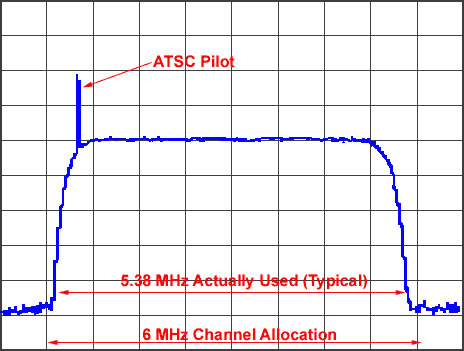
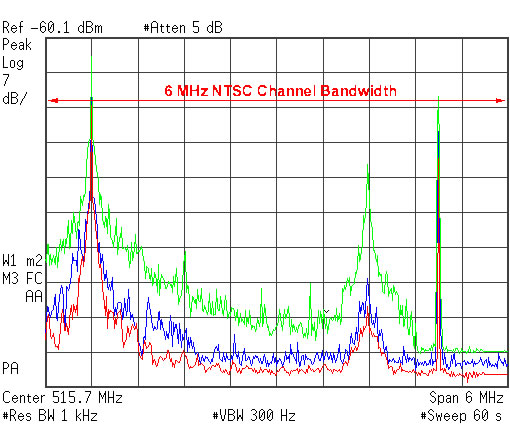
First, some background. I'm a software engineer with a minor in Electrical Engineering, and also a ham radio operator. While that doesn't mean I'm an expert, I do know my way round electrical testing and making measurements. However, this was no a truly scientific study - I just wanted to get HD reception over-the-air.
I'll be using the terms TV to mean the older analog TV signals, and DT to mean the digital TV signals. For a more detailed explanation of the signals, and why they look so different, go to this website for DTV and this website for NTSC (analog).
I had been puttering around with a VHF/UHF antenna, trying to get HD reception. I finally put up a UHF only antenna (Channel Master 4-Bay) high on the house, relatively clear (still have some trees in the way), and while better, HDTV was still a bit out of reach. So, I borrowed a spectrum analyzer to look at the signals very specifically and in great detail. Here's what I found.
I'm about 11 miles from the transmitter site on Lookout Mountain, and about 16 miles away from Squaw Mountain, another transmitter site. The two sites are, however, quite a ways from each other in angle - I compromised some on the angle. I am not line-of-sight from either transmit location. There are mountains in the way. Consequently, I had been using an amplifier in an attempt to boost the signals. But, when I added two amplifiers, I got fewer stations. So, I went to the FCC website looking for transmitters in close proximity, assuming that one of them was interfering. Specifically, I was looking for the one that was causing the signal from KCNC‑DT (UHF Channel 35) to be interfered with. I assumed that there was a station close by that was the interfering signal. Now, I'm using no amplifiers at all, and reception is better, not yet great. But I'm getting ahead of myself.
I concentrated on the "pilot carrier" of the HDTV (aka ATSC) signal because it is a narrowband signal that peaks 300 KHz from the low channel frequency edge. It should provide a good marker for the stations, and should give me good relative measurements for signal strength. The FCC website called out a transmitter on UHF channel 41 at 2,200 kilowatts (kw) effective radiated power (ERP) and its companion DT transmitter at 1,000 kw ERP. I figured that these were the interfering signal, so I'd look there first. But I was unsure if it was the DT or TV signal that was the interferer, or both. So, I had to look for the NTSC signals as well. Below you'll see spectrum analyzer plots for both signal types. The relative scale of each division is 10 dB, although the actual signal amplitude of the ATSC signal is unknown in these plots. They do look quite different, and that's because they use different modulation techniques to get the video and audio sent to you.
The following table represents almost all of the DT and TV stations in Denver. The other stations don't have interest for me, or are too low in power and too far away for me to pick up in my mountain location. Here's the station call letters, the low end of each channel's frequency, the transmit power of the station, it's bearing to me and distance, and the transmit antenna altitude, In the next to the last column, you'll see the pilot carrier measurement of the digital signal, followed by notes. These measurements were made with no pre-amplifiers. Some stations have duplicate entries because they have been licensed (at one time or another) to transmit from different locations at different power levels.
| Station | Type |
Freq |
Digital Channel |
Channel ID |
Power (kw) |
Distance (mi.) |
Bearing (deg) |
Antenna Altitude (am) |
Pilot Carrier (dBm) |
Notes |
| KWGN‑TV | TV |
54 |
2 |
2 |
100 |
11.1 |
0 |
2344 |
||
| KCNC‑TV | TV |
66 |
4 |
4 |
100 |
10.9 |
0 |
2462 |
||
| KCNC‑TV | TV |
66 |
4 |
4 |
100 |
11.0 |
1 |
2383 |
||
| KRMA‑TV | TV |
78 |
6 |
6 |
100 |
7.1 |
8 |
2363 |
||
| KRMA‑TV | TV |
78 |
6 |
6 |
100 |
11.0 |
356 |
2349 |
||
| KMGH‑TV | TV |
84 |
7 |
7 |
316 |
10.9 |
360 |
2336 |
||
| KMGH‑TV | TV |
84 |
7 |
7 |
316 |
11.0 |
1 |
2367 |
||
| KUSA‑TV | TV |
96 |
9 |
9 |
316 |
10.9 |
0 |
2319 |
||
| KUSA‑TV | TV |
96 |
9 |
9 |
316 |
11.0 |
1 |
2367 |
||
| KBDI‑TV | TV |
114 |
12 |
12 |
226 |
15.9 |
299 |
3508 |
Squaw Mountain transmitter site (now DT Only!) |
|
| KTFD‑TV | TV |
470 |
14 |
14 |
2400 |
7.0 |
8 |
2385 |
||
| KTFD‑TV | DT |
476 |
15 |
14 |
1000 |
7.0 |
8 |
2397 |
‑83.6 |
|
| KUSA‑TV | DT |
482 |
16 |
9 |
37 ** |
11.0 |
1 |
2384 |
‑77.0 |
UNK whether this is the real Tx power |
| KMGH‑TV | DT |
488 |
17 |
7 |
30 ** |
11 |
1.07 |
2338 |
‑81.0 |
UNK whether this is the real Tx power |
| KRMA‑TV | DT |
494 |
18 |
6 |
1000 |
7.1 |
8 |
2361 |
KRMA is not operating at this power or location yet. |
|
| KRMA‑TV | DT |
494 |
18 |
6 |
1000 |
7.1 |
8 |
2361 |
KRMA is not operating at this power or location yet. |
|
| KTVD | DT |
500 |
19 |
20 |
1000 |
11.0 |
1 |
2384 |
‑71.3 |
|
| KTVD | TV |
506 |
20 |
20 |
5000 |
7.0 |
7 |
2416 |
||
| KTVD | TV |
506 |
20 |
20 |
5000 |
11.0 |
1 |
2349 |
||
| KDVR | TV |
572 |
31 |
31 |
5000 |
10.9 |
360 |
2347 |
||
| KDVR | DT |
578 |
32 |
31 |
1000 |
10.9 |
360 |
2347 |
‑77.4 |
|
| KWGN‑TV | DT |
590 |
34 |
2 |
1000 |
11.1 |
0 |
2341 |
‑75.0 |
|
| KCNC‑TV | DT |
596 |
35 |
4 |
1000 |
11.0 |
1 |
2384 |
‑78.0 |
|
| KBDI‑TV | DT |
614 |
38 |
12 |
42 |
15.89 |
298.86 |
3499.3 |
‑84.0 |
Squaw Mountain transmitter site |
| KRMT | DT |
626 |
40 |
41 |
74.8 ** |
2.4 |
35 |
2438 |
‑78.0 |
UNK whether this is the real Tx power |
| KRMT | DT |
626 |
40 |
41 |
1000 ** |
2.4 |
35 |
2438 |
*** |
UNK whether this is the real Tx power |
| KRMT | TV |
632 |
41 |
41 |
2223 |
2.4 |
35 |
2438 |
The stations that I consistently have trouble with (i.e. not getting a good signal all the time) are KTFD‑DT (Ch 15 at ‑83.6 dBm), KCNC‑DT (Ch 35 at ‑78.0 dBm), and KBDI‑DT (Ch 38 at -84 dBm). From the Pilot carrier data, one would think that KUSA‑DT (Ch 16 at -77 dBm), KDVR‑DT (Ch 32 at ‑77.4 dBm) and KMGH‑DT (Ch 17 at -81 dBm) should also give trouble, but they don't! They always seem to be solid signals.
What makes little sense is that KMGH‑DT, KCNC‑DT, KUSA‑DT, KTVD‑DT all transmit from the same physical site, using the same physical antenna. Yet, there are over 10 dB of difference between the received signal strength from the lowest to the highest. All these stations are also supposedly operating at the same ERP (1000 kw).
I made a large number of measurements of the signals, comparing the signals from a number of transmitters (as seen above) to try to understand these variable results, and why adding an amplifier didn't really seem to help.
I started with the bare antenna, and looked at the broader spectrum of the entire UHF band of interest, from channel 14 through channel 41. Frequency measurements are approximate (spectrum analyzer limitation).
Here is a picture of what I saw:
The bright marker is at KTVD‑TV (506.9 MHz) is by far and away the strongest signal observable. And, based on the FCC data, probably should be. The signal I thought was interfering (KRMT‑TV at 626 MHz) was quite a bit smaller. Even though the KRMT‑TV transmitter is closer, the antenna pattern beams the majority of energy out onto the plains of Colorado, so this difference is explainable. While difficult to see, the digital signals are in there, but at lower signal levels than their TV equivalents. So some explanation is needed.
The TV signal and DT signals differ in the amount of energy in the specified bandwidth of the spectrum analyzer, so the DT signals will always show a lower signal strength, even at the same power levels. So, I undertook a series of measurements of each 2-channel frequency spread, starting at channel 14, and going through channel 42. There is a wide area in the middle of the channels that have no local stations, so I'll eliminate any empty segments.
Here are the segments, and descriptions of the stations being received. The measurements noted in the descriptions may not precisely match the pictures, because the scanning process was continuing as I set up the photos.
 |
KTVD Pilot Carrier at 476.31 MHz KTVD‑TV Video Carrier at 471.2 MHz |
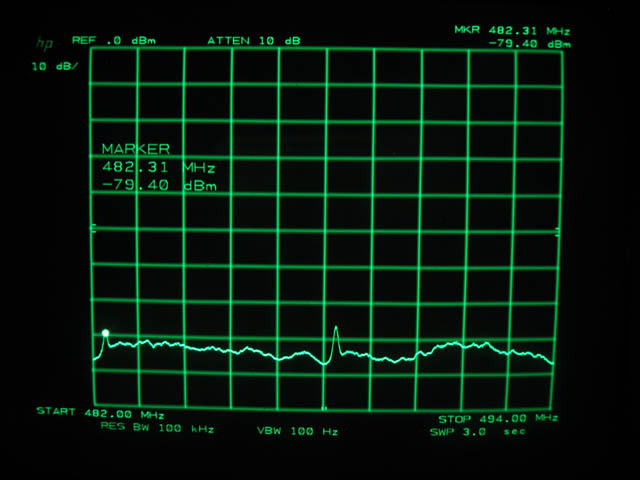 |
KUSA‑DT at 482.3 MHz KMGH‑DT at 488.3 MHz |
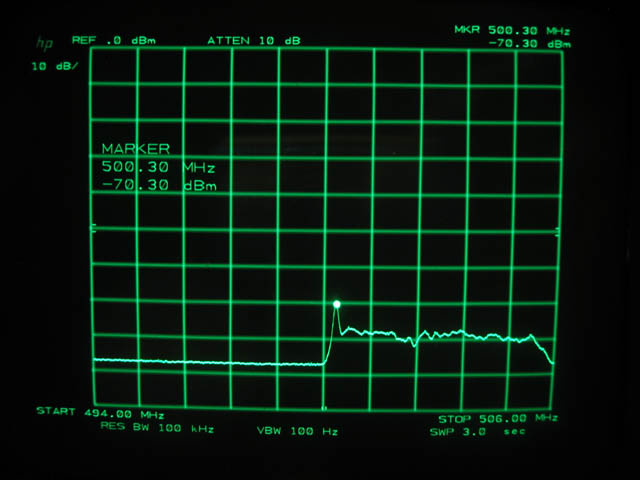 |
KTVD‑DT at 500.3 MHz |
 |
KTVD‑TV (Video Carrier at 507.27 MHz) |
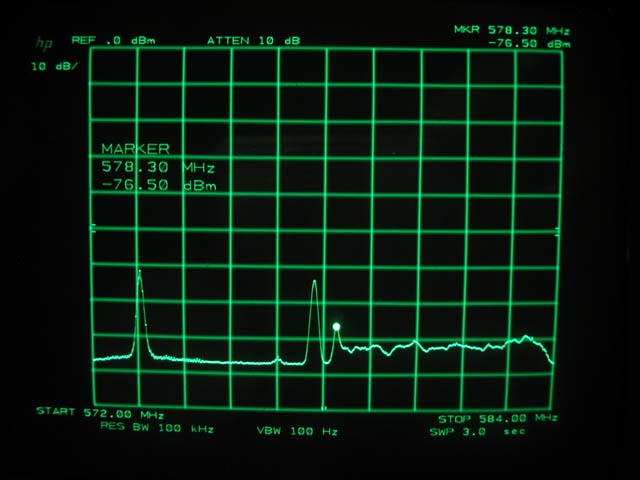 |
KDVR‑TV (Video carrier at 573.26 MHz) KDVR‑DT at 578.3 MHz |
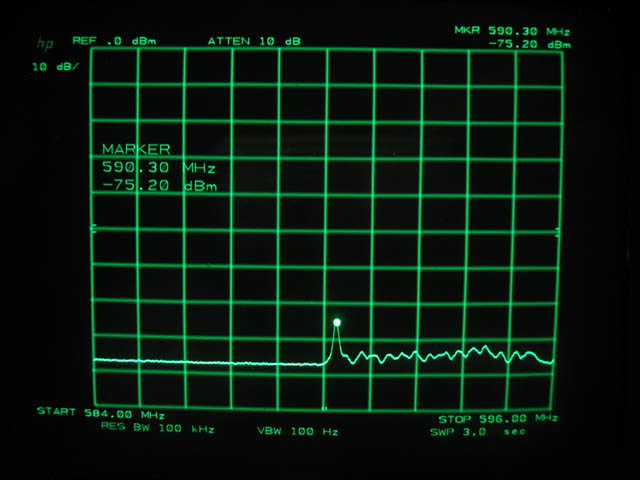 |
KWGN‑DT at 590.3 MHz |
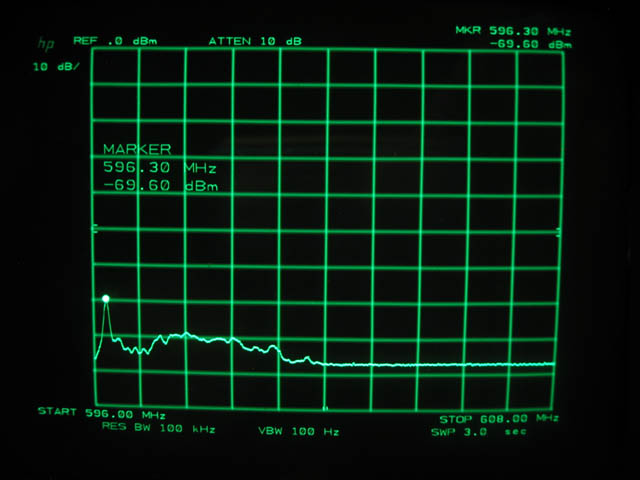 |
KCNC‑DT at 596.3 MHz |
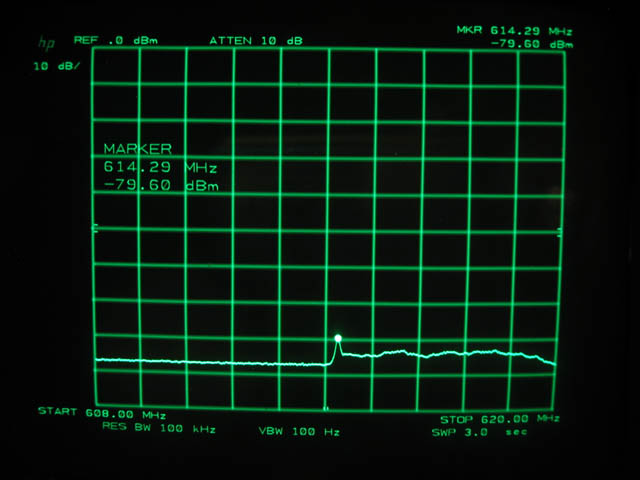 |
KBDI ‑DT at 614.3 MHz |
 |
KRMT‑TV (Video carrier at 623.6 MHz) |
 |
KRMT‑DT at 626.3 MHz |
I then decided to add one of the many amplifiers I have available (UHF only, VHF/UHF) and see why the addition of an amplifier would actually reduced the number of stations I could receive. First, I tried the UHF only (450 MHz to 2400 MHz) in-line amplifier from Radio Shack. My first measurement was to establish the baseline for the noise that would be introduced by the amplifier without any antenna connected. Boy, was I surprised.
The largest signal presence was from KTVD‑TV, a whopping ‑12.6 dBm. Previously, I had measured this signal at ‑45.5 dBm directly at the antenna. The other signals present at the right hand side of the scan are from KRMT (‑DT and ‑TV). This told me that the KTVD signal was far stronger than I had imagined, and that the amplifier was picking up enough energy from the one signal to amplify it a great deal (32 dB vs the 20 dB the amplifier was rated for). KRMT‑TV is seen at the -54 dBm level without the antenna.
Connecting to the antenna showed that yes, indeed, the amplifier was working, but now the signals looked a bit odd. Specifically, KTVD's signal level went to -26 dBm, while KRMT's signal went to -35 dBm. KRMT showed a 20 dB increase in signal level (expected), while KTVD showed a 14 dB decrease in signal level. In addition, although the visual comparison is not scientific, the signals look odd compared to the previous wide scan of the band. Specifically, it would appear that the KTVD signal is overpowering the amplifier, probably causing it to go into "compression". Compression, in my experience, causes the resulting signal to be really messed up and not be representative of the original signal. This would explain why having the amplifier resulted in fewer DT signals being decoded.
Trying out other amplifiers really show that they were no longer working. Here we have an Archer (Radio Shack) amplifier (UHF/VHF with FM trap enabled), and its spectrum looks way messed up!
Ok, so throw that amplifier out! Worked fine (or so I thought) for VHF, but it appears to be oscillating badly. Which explains why, when this amplifier was inserted, I could decode no DT signals at all. Still, I wanted to see if the Archer amplifier had the same issues that the in-line amplifier did, specifically, amplification of the KTVD signal with no antenna connected. That scan is below.
Here, KRMT is at ‑53.6dBm, while KTVD‑TV is at ‑45.9 dBm. Apparently, not as much coupling as the in-line amplifier. This is more consistent with the scan taken with just the bare antenna, where KRMT‑TV is about 10 dB lower in signal level than KTVD-TV. Also, many of the other UHF signals that the in-line amplifier did not apparently pick up are present on this scan. I think that means the amplifier has much more gain than expected, and that would explain the oscillation (feeding back on itself).
I re-performed these scans using a different VHF/UHF Radio Shack antenna. This antenna is almost ground mounted, pointing nominally at Lookout Mountain, and pointed in a slight (10 degree) negative elevation angle. While the in-line amplifier helped with the local TV stations, the results for the DT signals were pretty much the same; meaning, I could not get a good decode on most of the stations.
I conclude from this little test that when KTVD finally leaves the air on April 16, 2009, my problems may be solved. Specifically, without that 5000 kw signal being so well received, I can put in the in-line amplifier, boosting the signals of interest, and finally enjoying HDTV the way it was meant to be enjoyed.
If you've found this enlightening in any way, or would like more information, e-mail me at "bill" c/o this domain (horgerfamily.org).